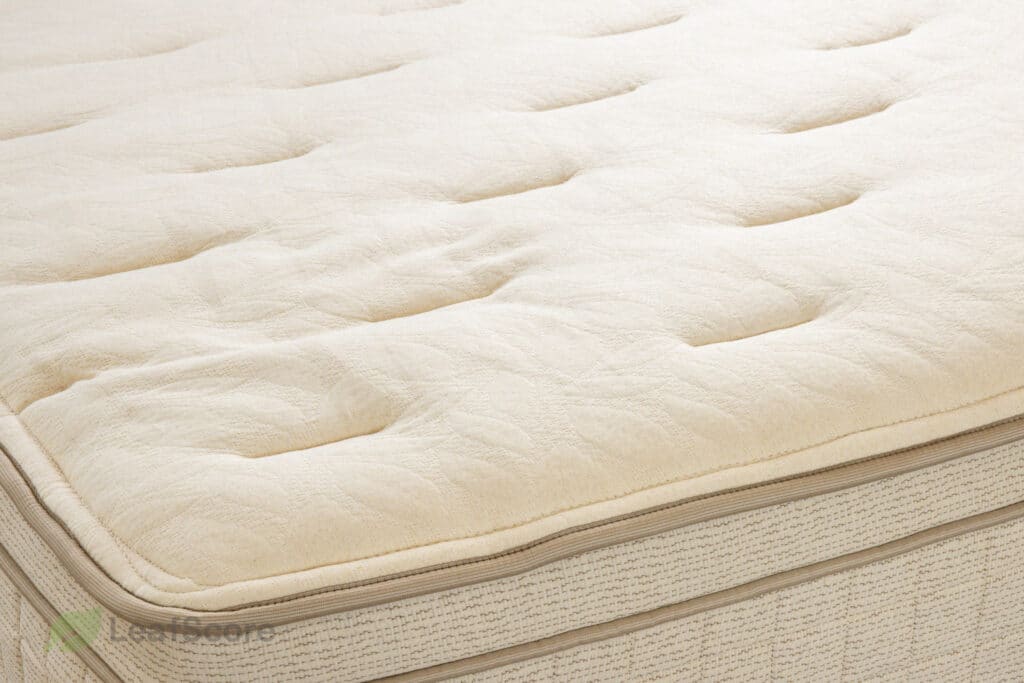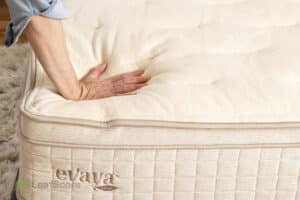In the Leaf Score Guide to Mattresses, we look at the perils of polyfoam and how to avoid toxic chemicals in mattresses. With all the bad stuff out of the way, though, what’s left? Here, we look at the best natural materials for an eco-friendly mattress.

Table of Contents
Why do natural materials matter in mattresses? In short, natural materials don’t off-gas harmful chemicals, typically have a lower carbon footprint and overall environmental impact compared to synthetic materials, are more comfortable and safe to sleep on, last longer, and are biodegradable and recyclable at end of life.
The best green mattress materials
Some eco-friendly mattress materials to look out for include:
- Kapok
- Organic wool
- Organic cotton
- 100 percent natural latex
- Hemp
- Recycled steel coils.
Regardless of how firm or soft you like your mattress, choosing a model made with natural materials is better for breathability, comfort, durability, and all-round health.

Evaya Organic Mattress [Staff Tested]
Eco-Institut and Made Safe Certified, will never off-gas, and certified to be free of even trace amounts of hazardous chemicals. Manufactured using EverEden Premium wool sourced from New Zealand farmers.
A quality mattress can easily last for several decades without needing to be replaced, if well cared for. And, if more people choose an eco-friendly mattress, this could help to keep millions of tons of material out of landfill and vastly reduce consumption of petroleum products and related greenhouse gas emissions.
Keep in mind, that with the exception of kapok, many organic mattresses are made with a combination of organic cotton for the cover, wool for comfort and as a natural flame retardant, and latex in the core of the mattress. Even pure latex mattresses are usually made with an organic cotton cover.
Pros and cons of kapok in mattresses
Kapok is a fascinating material and increasingly popular in clothing and other textiles. It remains rather underused in mattresses, however, though some are starting to integrate it as a soft, comfortable, moisture wicking pillowtop layer.
Kapok is lightweight, soft, and sustainable. It offers a good alternative to down, which is known to harbor dust mites and isn’t vegan-friendly. Kapok can also be an excellent material for pillow-tops, because it can help with temperature regulation (just like wool).
In recent years, more companies have begun offering kapok as an eco-friendly pillow fill. Unlike wool, though, kapok hasn’t been proven flame resistant, which means mattress makers will still likely pair it with wool in any natural mattress designs.
Note, too, that because kapok is quite soft, it’s not a good choice for a crib mattress, which needs to be firm to be safe. For adults and older children, kapok can provide plush cushioning, though.
Pros and cons of wool mattresses
Wool naturally wicks moisture away from your skin and is flame-resistant and antimicrobial. A wool pillowtop is excellent, then, for maintaining a constant temperature without off-gassing nasty chemicals.
A breathable, organic wool covered mattress can help you stay cool on summer nights while keeping you warm and cozy in winter, with wool shown to help fitful sleepers get a better night’s rest (R, R). Wool is also naturally resistant to mold and mildew and dust mites, making it a great option for allergy sufferers.
Wool is a little firmer than kapok and some other materials, so it’s best suited to those looking for a slightly firmer mattress, such as stomach-sleepers or heavier adults. It can also feel quite flat and dense and doesn’t conform to your body as other mattress toppers might. Fortunately, most mattresses using a wool cover have a good layer of more ‘bouncy’ latex underneath, providing a good combination of materials for comfort, coziness, breathability, and safety.
As noted, the downsides of wool include its relative lack of ‘bounce’ compared to latex (or foam). If a mattress is made mostly of wool, this would require a lot of material, which makes for a heavy product and greater resource use. Although not a synthetic product, wool production does have an impact on the environment and wool that isn’t organic may be produced with chemical pesticide and fertilizer inputs and other chemicals such as bleach.
Wool is also not vegan-friendly, although some sources of wool are considerably better in terms of animal welfare. In the US, wool marked with the PureGrow™ label comes from Californian farms that practice sustainable sheep ranching. EcoWool is similar. Wool-certified USDA Organic is also a decent option, as is any wool product with GOTS certification. To really up your eco game, look for organic wool that carries the European kfB certificate awarded to products made with wool sourced with minimal animal exploitation.
Bear in mind that if you want an eco-friendly mattress free from chemical flame retardants, chances are that this will mean a mattress encased in a thin layer of wool.
To get a mattress thicker than 5 inches without the wool barrier requires a doctor’s note stating that you have an allergy to wool. If a mattress company sells you a mattress thicker than 5” without wool, and claims their mattress is free from chemical flame retardants, they are contravening federal fire safety regulations and are either misleading you about what’s actually in the mattress or are deliberately or unwittingly flouting the law and putting your safety at risk.
Our top mattress pick made with a wool “comfort layer” is the Evaya Bliss, which we carry in our online store. You can use code ESSENTIALEVAYA for 15% off.

Evaya Organic Mattress [Staff Tested]
Eco-Institut and Made Safe Certified, will never off-gas, and certified to be free of even trace amounts of hazardous chemicals. Manufactured using EverEden Premium wool sourced from New Zealand farmers.
Check out our top picks for cotton and wool futons here.
Pros and cons of organic cotton mattresses
Conventionally grown cotton is resource-hungry and involves the use of pesticides and other chemicals that damage the environment and are bad for human health. Organic cotton is grown and processed without pesticides, formaldehyde, or other harmful chemicals and is very soft, making it an excellent option for the top layer of mattresses.
Many eco-friendly mattresses have organic cotton covers and include cotton-wrapped coils and cotton batting. Mattresses that contain a lot of cotton tend to be heavier and feel firmer than foam mattresses. They can flatten over time, however, so cotton is usually combined with other materials, such as 100 percent natural latex, to help maintain shape. Or, consider an innerspring mattress with a layer of organic cotton batting and wool batting as a fire barrier. Research shows that a medium-firm innerspring mattress can offer “immediate and significant improvements in sleep quality, sleep efficiency, and stress”.

Evaya Organic Mattress [Staff Tested]
Eco-Institut and Made Safe Certified, will never off-gas, and certified to be free of even trace amounts of hazardous chemicals. Manufactured using EverEden Premium wool sourced from New Zealand farmers.
Pros and cons of natural latex mattresses
We look at the pros and cons of natural latex for mattresses in more depth here. Suffice it to say, though, that latex is:
- Renewable
- Recyclable
- Biodegradable
- Breathable
- Good for thermoregulation (great if you sleep hot!)
- Durable
- Bouncy and responsive (but not too bouncy)
- Non-toxic
- Comfortable
- Great for pressure relief and weight distribution
- Antimicrobial and doesn’t harbor dust mites or mildew
- Easy to care for.
Of note, latex is porous and disperses heat really well. According to one study, “Latex mattress reduced peak body pressure and achieved a more even distribution of pressure compared with polyurethane mattress across different sleeping postures.”
The downsides of latex are that it requires more time and effort to produce compared to polyfoam. This makes it a more costly mattress material.
Latex mattresses can also smell a little of rubber at first, though this dissipates very quickly and isn’t harmful. It’s nothing like the same as a polyfoam mattress off-gassing VOCs.
Most latex in mattresses is either Talalay or Dunlop. We discuss the differences in those here. In general, Dunlop tends to feel firmer than Talalay.
Pros and cons of hemp mattresses
Hemp is a wonderfully sustainable, renewable resource with myriad applications across multiple industries. Mattresses made with hemp are few and far between, however. Still, if you live in a hot and humid climate (or are concerned that climate change will soon make it so), it could be worth looking for a hemp mattress.
Hemp is one of the most breathable materials available (R). It helps you stay cool even in hot and humid temperatures and helps wick moisture away from your skin. This means it’s good for keeping your mattress feeling fresh, especially as hemp is naturally anti-microbial and anti-bacterial. Hemp is resistant to mold and mildew and doesn’t hold onto odors.
As mentioned, hemp mattresses are rare. If you do find one, they tend to be expensive. Hemp is also not the softest material, meaning it’s a poor choice for side-sleepers and lighter adults.
If you’re prone to back pain, a hemp mattress is also not a great choice. It may be a good fit for some people with nerve pain though, who can benefit from firmer support.
Hemp is a very environmentally friendly fiber as the crop is naturally resistant to pests and grows so thick that it prevents the growth of weeds around the plants. This means that you don’t typically need to use pesticides or herbicides when growing hemp, nor do you need fertilizers as hemp actually enriches the quality of soil. Because hemp roots grow deep, they are good at using groundwater and help reduce soil erosion.

Evaya Organic Mattress [Staff Tested]
Eco-Institut and Made Safe Certified, will never off-gas, and certified to be free of even trace amounts of hazardous chemicals. Manufactured using EverEden Premium wool sourced from New Zealand farmers.
Reduce, reuse, recycle
Landfills are heaped high with toxic mattresses made from memory foam and synthetic latex. Landfills are also home to ‘natural’ mattresses that were treated with harsh chemicals that make them impossible to recycle and less biodegradable than you’d think. These chemicals can also leach into water and soil, causing considerable pollution.
Sadly, many of the millions of mattresses that go to landfill each year still have years of useful life left. These could have been given to shelters or donated through community networks to folks in need. Of course, if a mattress is truly toxic, no one should be made to sleep on it. Recycling programs can reclaim usable parts of a mattress, such as metal coils and zippers, and some fabrics and batting.
Some mattress companies have a removal program where they take away your old mattress upon delivering your new mattress. Check what happens to the old mattress in such cases. Does the company have a dedicated recycling and safe disposal protocol, or will it just end up in local landfill?
If you need to dispose of a mattress yourself, contact your local recycling depot or waste management department for advice. They may offer pick-up for safe disposal or can tell you where to take your old mattress yourself.
As always, natural plant-based materials are the best options for truly biodegradable, eco-friendly mattresses. This means organic latex, cotton, wool, hemp, and kapok. Now you’re familiar with natural, non-toxic mattress materials, check out our recommendations for the best overall eco-friendly mattresses.